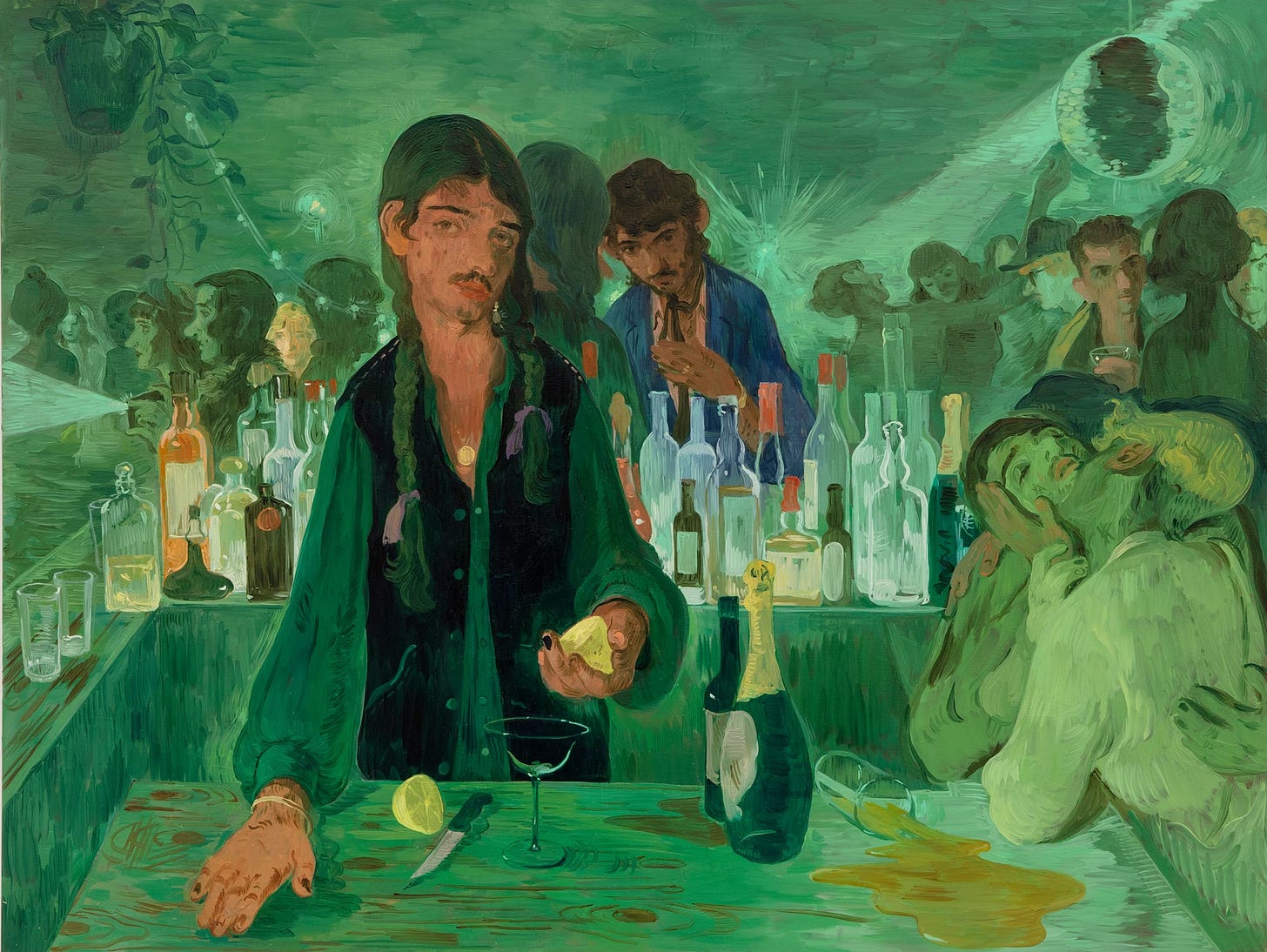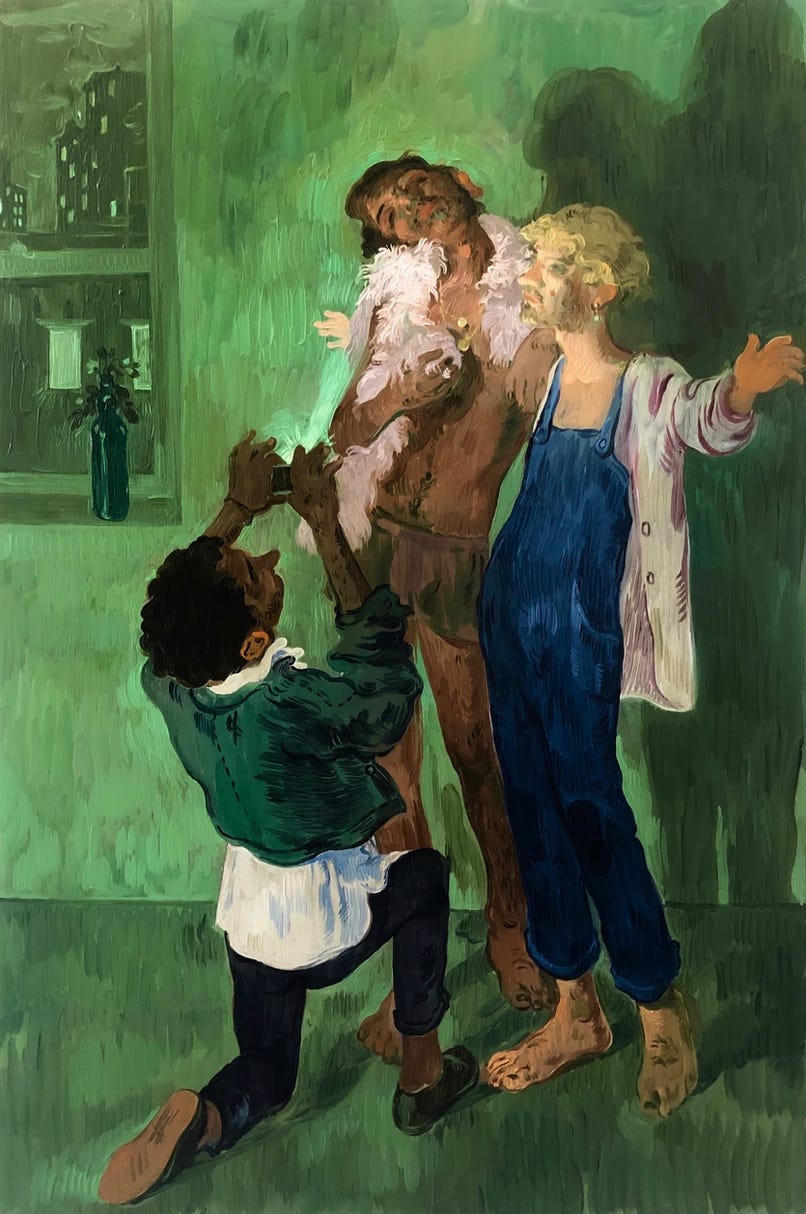Your weekly exploration of art and its mediums. The stories we tell and the ways we tell them.
A collection of things I’ve seen. This week’s story I first saw on the Whitney Museum’s instagram page after Salman Toor’s exhibition How Will I Know was put on pause at the start of New York’s lockdown due to COVID-19, it has since reopened.

Four Friends, Salman Toor, 2019
Salman Toor is a Pakistani painter based in New York. His paintings have been described as narrative paintings or auto-fiction works, since the scenes are heavily based on his own identity as a queer brown immigrant in New York. His paintings share recurring color palettes and the same movement inducing brush strokes of characters.

The Bar on East 13th Street, Salman Toor, 2019
Toor uses the self as a conduit to create worlds and characters in the middle of his own intersections. The perspective of his paintings feel like open windows or even that you are there in the room staring at the characters. Through your gaze as a viewer the figures are othered just as Toor as felt in his own life. Their own expression makes the viewer feel as if you have already judged them and it is hard to figure out if they care or not.

Man with Face Creams and Phone Plug, Salman Toor, 2019
There are a couple of paintings in this series that focus on how brown men are singled out in airport immigration and customs post 9/11. Their belongings strewn out publicly on a table and looking down in defeat. Privacy is a luxury. The viewer becomes the officer on the other side of the table deciding the fate of these men.

Ambush II, Salman Toor, 2019
In other works Toor’s characters are passive in the gazes that are thrown upon them. A cop lurks around the corner, into the car of two men on a date, or even the viewer who gazes into the apartment of 4 friends dancing. They are used to these stranger’s gazes and are comfortable becoming other because on the another side, to themselves, they are themself.

The Green Bar, Salman Toor, 2018
Toor also plays with the public and private. In intimate spaces who are we and are we still othered by our own gaze, the comfort is played with and creates a border. An article published on the Whitney Museum of Art’s website titled, “The Self as Cipher”, quotes Homi K. Bhabha in his book The Location of Culture, “the borders between home and world become confused; and, uncannily, the private and the public becomes part of each other, forcing upon us a vision that is as decided as it is disorienting.” The figures are aware of two things at the same time, how they see themselves and how they are being seen. The private becomes public and the public, internalized.

Bedroom Boy, Salman Toor, 2019
My favorite paintings of Toor’s are the nudes. Being seen by someone can be both stimulating and debilitating. The images of naked bodies that Toor paints are completely alone other than the devices that often accompany them. Taking selfies while naked or watching a movie are both intimate and very public at the same time. The position of lounging feels very similar to the nude positions of a European nude paintings of women laying on large couches. A large part of Toor’s depictions are that brown people are present in today’s society within modern painting. They are going to bars, have laptops, naked and lounging in relaxation yet still brown and still hairy.

Three Boys, Salman Toor, 2019
Toor establishes his often queer and brown characters within a position of privilege or relative luxury, dancing and fluid in a way that is not often seen in galleries. Toor lets them be, compared to the usual Western racial canon of brown men. His green paintings are, “a space of self; for enhancing the self”. They are spaces of glamour backed by the emerald background. “The green stands for what figures cannot say out loud the dysfunction, difference, and, again, transgression that separate the young man from the rest of his family”.

After Party II, Salman Toor, 2019
Toor’s scenes are both liberating and caging, in moments of elation and labeling his figures sway and watch and are watched. They are normal. On the phone or taking a shower, Toor’s figures are himself in his most vulnerable while being watched by the viewer and those that peer around the corners who decide they know him before he speaks.
— Anayah
For more information:



